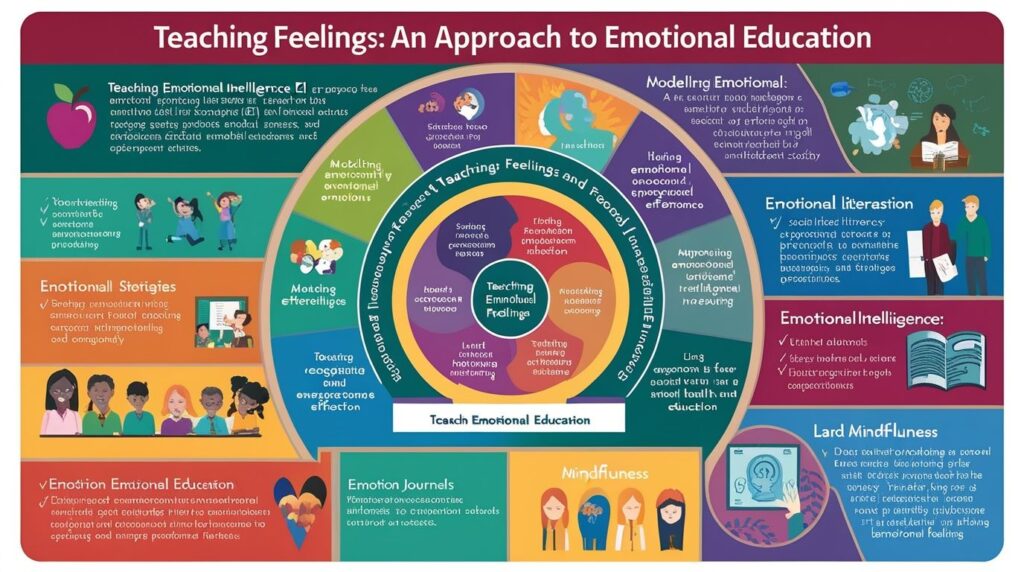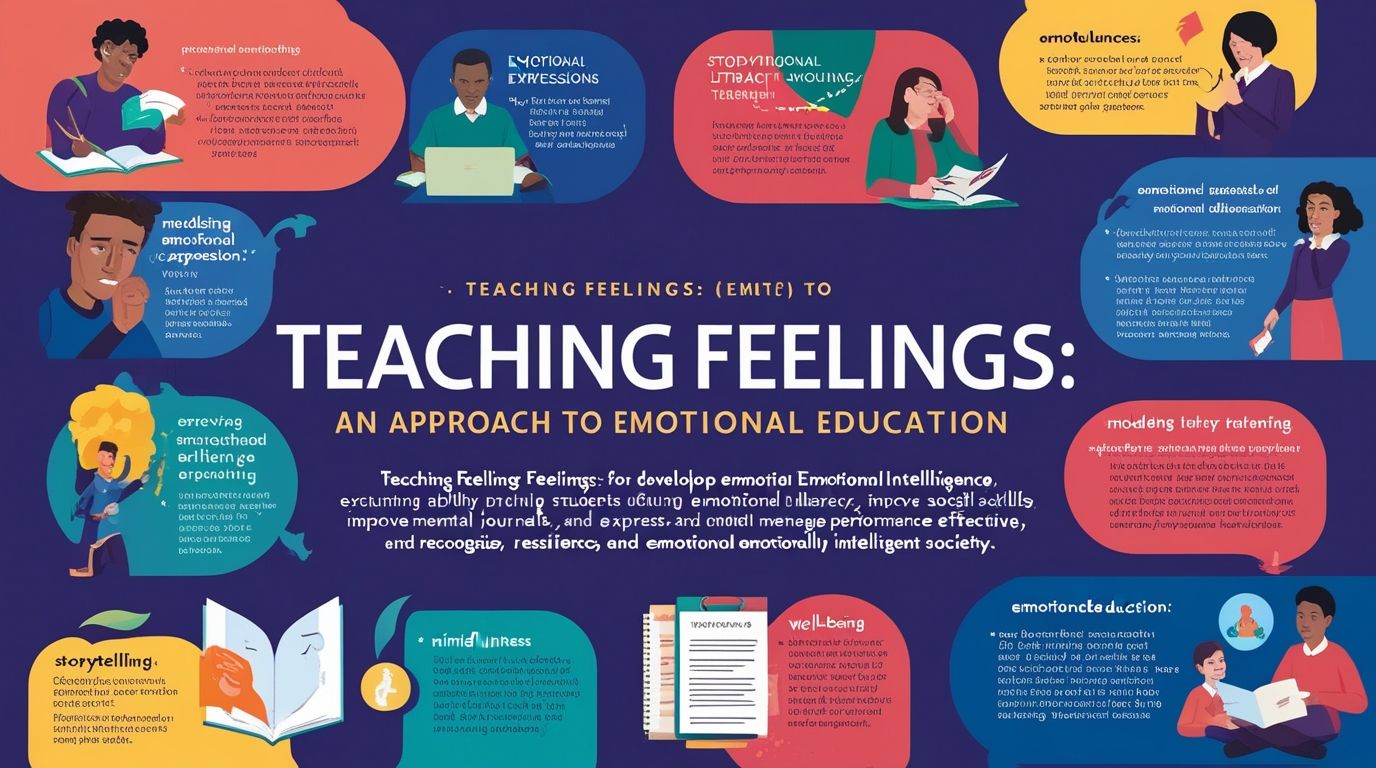Teaching Feelings an Approach to Emotional Education, In today’s rapidly evolving educational landscape, teaching is no longer just about imparting knowledge of academic subjects. Emotional intelligence (EI), or the ability to recognize, understand, and manage one’s own emotions and the emotions of others, is becoming a critical aspect of overall development. Teaching feelings, which is an integral part of emotional education, plays a crucial role in shaping a student’s well-being, interpersonal skills, and success in life. This article explores the significance of teaching feelings in educational settings, effective strategies, challenges faced by educators, and the long-term impact of emotional literacy.
Importance of Teaching Feelings
Feelings are fundamental to human experience. They influence decision-making, relationships, and overall mental health. Yet, many students grow up without the tools to express their emotions healthily. Teaching feelings helps address this gap, fostering emotional awareness and resilience. When students learn to identify and articulate their emotions, they become better equipped to navigate challenges, manage stress, and build stronger relationships.
- Emotional Regulation and Mental Health
A key benefit of teaching feelings is improved emotional regulation. Emotional regulation is the ability to manage and respond to emotions in a socially acceptable and constructive way. This is crucial for students as they encounter stress, frustration, and peer pressure. Without the ability to manage emotions, students are at risk of developing anxiety, depression, and other mental health disorders. Teaching feelings from a young age equips students with coping mechanisms to handle life’s difficulties. - Improving Social Skills and Relationships
Emotional education fosters better social interactions. Children who understand and express their emotions are more likely to empathize with others, leading to improved interpersonal relationships. By teaching feelings, educators help students develop empathy, a key component of social cohesion. Empathy allows students to consider the feelings of others and build healthy, supportive friendships. - Boosting Academic Achievement
Contrary to the assumption that focusing on emotions detracts from academic learning, emotional intelligence supports academic success. Students who can manage their emotions are better able to concentrate, persist in the face of challenges, and collaborate with peers. Studies have shown that schools that incorporate emotional literacy programs often see improvements in overall academic performance. This is because emotionally intelligent students tend to have higher levels of self-motivation and fewer distractions caused by emotional disturbances. - Lifelong Benefits
Emotional literacy is not just a tool for childhood but a lifelong asset. Adults who are emotionally intelligent tend to have better career outcomes, healthier relationships, and overall life satisfaction. By embedding emotional education in the school curriculum, educators provide students with skills that will benefit them for years to come.
Effective Strategies for Teaching Feelings
Teaching feelings can be integrated into the curriculum in various creative and age-appropriate ways. Below are some strategies that educators can use to enhance emotional literacy among students.
- Modeling Emotional Expression
One of the most effective ways to teach feelings is through modeling. Teachers who openly express their emotions in appropriate ways set a powerful example for students. This involves more than simply naming emotions; it includes demonstrating how to handle difficult emotions constructively. For instance, a teacher might say, “I’m feeling frustrated because things aren’t going as planned, but I’m going to take a deep breath and think of a solution.” This shows students how to recognize and manage their own frustrations. - Using Storytelling and Literature
Literature and storytelling are excellent tools for teaching feelings, especially in younger students. Many children’s books focus on emotional themes and can be used as springboards for discussion. For example, after reading a story about a character who feels sad, teachers can ask students questions like, “Why do you think the character felt that way? What could they do to feel better?” This helps students connect emotions to experiences and practice empathy. - Emotion Journals
Emotion journals are a reflective practice where students regularly write about their feelings and the events that triggered those emotions. This method encourages self-awareness and emotional articulation. Teachers can guide students in categorizing their emotions, identifying patterns, and brainstorming healthy ways to cope with negative feelings. Over time, students develop a greater understanding of their emotional landscape and feel more confident in expressing themselves. - Role-Playing and Scenario-Based Learning
Role-playing can be a fun and interactive way for students to explore emotions and practice empathy. Teachers can present hypothetical scenarios where characters face emotional challenges. For example, students might role-play a situation where one friend feels left out, and others must work together to resolve the issue. Through this exercise, students practice identifying emotions in themselves and others, and learn how to respond compassionately. - Mindfulness and Relaxation Techniques
Mindfulness practices, such as deep breathing, meditation, or progressive muscle relaxation, are highly effective in helping students regulate their emotions. By incorporating short mindfulness sessions into the school day, educators can provide students with tools to manage stress and anxiety. These techniques teach students to focus on the present moment, allowing them to approach their emotions with calmness and clarity. - Emotion Charts and Vocabulary Building
Providing students with an extensive emotional vocabulary is crucial for emotional education. Emotion charts, which visually display a range of feelings (from happiness to sadness to anger), help younger children associate words with their feelings. Teachers can encourage students to move beyond simple terms like “happy” or “mad” and use more nuanced language, such as “frustrated,” “disappointed,” or “ecstatic.” By expanding their emotional vocabulary, students can express themselves more precisely.

Challenges in Teaching Feelings
Despite the importance of emotional education, there are several challenges that educators may encounter while teaching feelings.
- Cultural Differences
Emotional expression varies greatly across cultures. Some cultures encourage open expression of emotions, while others may prioritize restraint. This can create challenges in diverse classrooms where students come from different cultural backgrounds. Teachers need to be sensitive to these differences and ensure that emotional education respects students’ cultural values. For instance, teachers may need to adjust their approach for students who come from cultures where discussing emotions openly is not encouraged. - Resistance from Students and Parents
In some cases, students may resist engaging with their emotions, especially if they have grown up in environments where emotional expression is discouraged. Likewise, some parents may question the inclusion of emotional education in the curriculum, believing that academic subjects should take priority. Educators must be prepared to explain the benefits of emotional literacy and find ways to engage reluctant students without forcing participation. - Balancing Academic Demands
Another challenge is balancing the time spent on emotional education with academic instruction. With increasing pressure to meet standardized testing goals and cover curriculum content, emotional education can sometimes be sidelined. However, integrating emotional literacy into daily routines rather than treating it as a separate subject can alleviate this pressure. Short activities, discussions, or mindful breaks can be easily incorporated without disrupting academic goals. - Limited Teacher Training
Many teachers do not receive formal training in emotional education, making it difficult for them to confidently teach feelings. Schools and educational institutions need to provide professional development opportunities to help teachers learn effective strategies for integrating emotional education into their classrooms. This can include workshops on emotional intelligence, classroom management techniques, and how to respond to students’ emotional needs.
Long-Term Impact of Emotional Education
The long-term benefits of teaching feelings extend far beyond the classroom. Emotionally literate individuals tend to have higher self-esteem, better mental health, and stronger interpersonal relationships. In the workplace, they are often more successful because they can manage stress, collaborate effectively, and navigate complex social dynamics. Additionally, emotionally intelligent individuals are better equipped to handle life’s inevitable challenges, making them more resilient in the face of adversity.
Emotionally literate adults also contribute positively to society. They are more likely to engage in prosocial behaviors, such as helping others, volunteering, and advocating for social justice. By teaching feelings, educators play a crucial role in creating compassionate, empathetic, and emotionally resilient individuals who can contribute to a healthier, more connected world.
Conclusion
Teaching feelings is a vital component of modern education. By fostering emotional intelligence in students, educators provide them with the tools they need to succeed both personally and academically. Emotional education helps students manage their emotions, develop empathy, and build positive relationships. While there are challenges in implementing emotional literacy programs, the benefits far outweigh the difficulties. By integrating emotional education into the curriculum, we can nurture a generation of emotionally intelligent, compassionate individuals capable of contributing to a better world.
References
- Goleman, D. (1995). Emotional Intelligence: Why It Can Matter More Than IQ. Bantam Books.
- Mayer, J. D., & Salovey, P. (1997). “What is emotional intelligence?” In Emotional Development and Emotional Intelligence (pp. 3-31). Basic Books.
- Denham, S. A. (2006). “Social–Emotional Learning in Early Childhood: What We Know and Where to Go from Here.” Handbook of Early Childhood Education.
- Elias, M. J., & Weissberg, R. P. (2000). “Primary Prevention: Educational Approaches to Enhance Social and Emotional Learning.” Journal of School Health, 70(5), 186–190.

7 thoughts on “Teaching Feelings an Approach to Emotional Education”
Comments are closed.